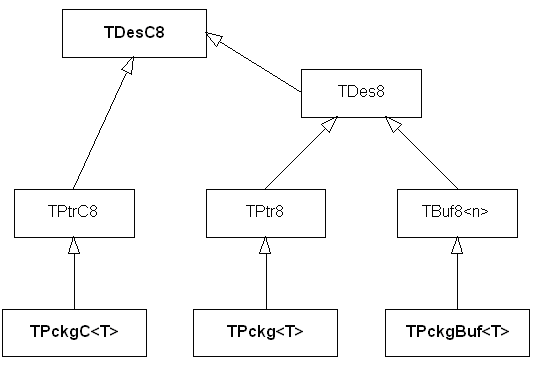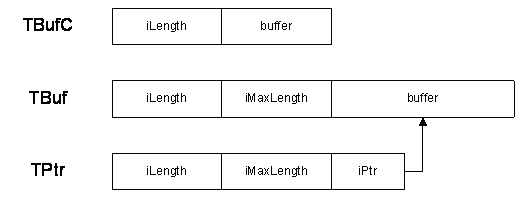Client/server communication
Inter Process Communication (IPC) is the basis for client/server architecture. Clients and servers run in different threads, although not necessarily in different processes, and communicate through message passing protocol. There are no direct pointers between the parties, leaving the integrity of the server and its resources untouched by clients. For more information, see Introduction to the client/server architecture.
Communication between the client and the server is managed by Inter-thread data
transfer. Only the server and its clients can decode the parameters
of the message. This is also a security feature, because process boundaries
are separators of memory space, direct pointers to the client's data
structures cannot be delivered. All data not fitting in the provided
integers must be represented as a descriptor, and an address to the
descriptor (or actually a TPckg object) is delivered
within the message. The server then uses safe inter-thread read and
write functions to access the provided descriptor.
The following figure shows the relationship of the TDesC8 and TPckg classes.

Figure: Relationship of a message package and a descriptor class
Consider the following issues when implementing the client-side API:
Determine if the server is already running with the
TFindServerclass. If not, then it should be launched.Once the server is running, create the connection with
RSessionBase::CreateSession()and make sure there are free message slots available to avoid lost messages.When packaging message arguments, make sure they are in a format that the server understands. For more information, see
TIpcArgs.
Descriptors
Descriptors are self-describing strings that can be used to store binary data and text. Each descriptor object holds the length of the string as well as its type which identifies the underlying memory layout of the data it holds. For more information on different descriptor classes, see Using Descriptors.
There are modifiable and non-modifiable descriptors, the latter
type is identified by a "C" suffix in the class name. The length of
a non-modifiable descriptor is defined when compiling an application,
and the length of a modifiable descriptor can vary within the limits
set by iMaxLength. Nonmodifiable descriptors are
more secure, as their length is checked during compilation. The following
figure shows the differences between these types.

Figure: Differences between modifiable, nonmodifiable, and pointer descriptors
When designing applications, avoid using fixed-length buffers
as parameters and use base classes (preferably constant base type TDesC) instead. Descriptor objects provide a flexible interface
for manipulating the contained string, including size and length checks.
Take advantage of these when possible.
For more information and examples, see the Descriptors Overview topic.